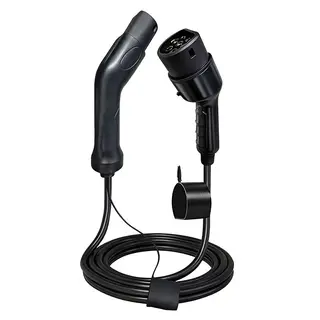With the increasing popularity of new energy vehicles, electric vehicle (EV) charging stations, as an important supplementary facility, have gradually entered people's daily lives. Charging stations not only provide convenient charging services for EVs but also, to a certain extent, promote the development of new energy vehicles. So, how exactly does a charging station work? What types and features does it have? This article will give you a detailed explanation of the principles and related knowledge of EV charging stations.
The system composition of an EV charging station is relatively complex, mainly including the following parts.
The input power distribution section is the key link connecting the charging station to the power grid. It mainly includes protective circuit breakers, surge protection devices, and an input power meter. The function of the breakers and surge protection devices is mainly to ensure the safe operation of the charging station. When the power grid experiences a voltage spike or a lightning strike, the surge protection device can discharge the excessive voltage to the ground, preventing damage to the internal electronic components of the charging station. The protective circuit breaker can quickly cut off the power supply when the circuit experiences a short circuit or other abnormal conditions, preventing accidents. The input power meter is mainly used to measure the electricity consumption of the charging station to achieve accurate billing. It collects usage data and uploads it to the backend management system for cost accounting and user fee settlement.
The control circuit is the brain of the charging station, responsible for coordinating the operation of the internal hardware components. Through the control circuit, the charging station can achieve precise control of the charging process, including regulating the charging current and voltage, as well as monitoring the charging status. Based on the actual condition of the EV battery, such as battery voltage and temperature, the control circuit automatically adjusts the charging strategy to ensure safe and efficient charging.
This is the main platform for user interaction with the charging station. It is usually equipped with an LCD screen that clearly displays charging data, such as charging volume, charging time, and fees. Users can operate this interface to choose charging modes (manual charging, card-swipe charging, etc.), set charging time, and so on. During the charging process, the interface also allows users to monitor the real-time charging status, including progress and remaining charging time.
The emergency stop button is one of the safety protection devices of the charging station. When the equipment malfunctions or an emergency occurs, the user can press the emergency stop button to quickly cut off the input power of the charging station. This measure effectively protects the equipment itself, prevents the fault from escalating, and avoids potential harm to the user or the surrounding environment.
The function of the card reader is similar to the bank card swiping devices we use daily. Users can use a dedicated charging card to swipe on the reader to complete payment settlement as well as start and stop control of the device. Through the card reader, the charging station can identify the user's account information, enabling billing and charging authorization management.
The output connector, usually referred to as the charging gun, is the key component connecting the charging station to the EV. The charging gun transmits the DC power generated by the charging station to the EV battery. During charging, the gun connects tightly to the EV's charging port to ensure stable energy transfer. To guarantee safety and reliability, charging guns are typically equipped with multiple protective devices, such as temperature sensors and insulation detection units.
The charging indicator light shows the current status of the charging station. Generally, it has three states: standby, fault, and charging. When the station is in standby mode, the light is green; if a fault occurs, the light turns red to remind the user to check; during charging, the light blinks or turns yellow, allowing the user to visually understand the station's working state.
The working principle of a charging station is mainly based on the transmission and conversion of electrical energy to charge the EV battery. The basic principle is: after the battery discharges, direct current is applied in the opposite direction of the discharge current to restore its capacity. During charging, the battery's positive electrode is connected to the power supply's positive terminal, and the battery's negative electrode is connected to the power supply's negative terminal. The charging voltage must be higher than the total electromotive force of the battery.
Currently, there are two main charging methods: constant-current charging and constant-voltage charging.
Constant-current charging is a method of charging the battery at a controlled, fixed current. The control method is relatively simple: by adjusting the output voltage of the charging device or changing the series resistance with the battery, the charging current is kept constant. However, since the battery's ability to accept current decreases as charging progresses, much of the current in the later stages is used to electrolyze water, producing excessive gas. Therefore, constant-current charging is usually combined with staged charging to improve efficiency and safety.
Constant-voltage charging charges the battery at a controlled, fixed voltage. During the entire process, the charging voltage remains constant, while the charging current gradually decreases as the battery terminal voltage rises. Compared with constant-current charging, constant-voltage charging is closer to the optimal charging curve, making it more efficient. In the early stage, the charging current is high because the battery voltage is low, but as charging continues, the current gradually decreases, requiring only a simple control system.
At present, the most common charging stations on the market are of two types: DC charging stations and AC charging stations, which differ in charging methods, speed, and installation scenarios.
DC charging stations are fixed charging devices installed in public locations outside EVs, such as residential communities, parking lots, business districts, and service areas. They connect to the public power grid and provide DC power to the EV battery. DC charging stations directly charge the EV battery, typically using a three-phase four-wire or three-phase three-wire supply. With wide adjustable output voltage and current ranges, they achieve rapid charging and are often referred to as fast chargers.
DC chargers have high output power, commonly available in 30kW, 60kW, 80kW, 120kW, 150kW, 180kW, and other specifications. With fast charging speed, they can recharge an EV in a short period, making them highly practical for long-distance travel or urgent charging scenarios.
AC charging stations are also fixed installations in public areas outside EVs. They provide controllable single-phase or three-phase AC power to the EV's onboard charger. Unlike DC charging stations, AC chargers cannot directly charge the EV battery. They only provide power output, and charging is completed through the onboard charger inside the EV.
Since onboard chargers generally have smaller power ratings, AC charging is relatively slower and is usually called slow charging. Typical power ratings are 3.5kW, 7kW, and 15kW. AC chargers are suitable for overnight charging at home or in offices, making them ideal for daily commuting and city driving.
Charging Method: DC chargers can directly charge the battery without relying on the onboard charger, while AC chargers require the onboard charger to complete the charging.
Charging Time: DC charging is faster, taking only tens of minutes to 2–3 hours to fully charge the battery, whereas AC charging usually takes about 8 hours.
After understanding the working principles and types of charging stations, let us look at the basic principles of EV charging. EV charging is based on the transmission and conversion of electrical energy, which includes DC charging and AC charging.
DC charging connects a DC power source directly to the EV's battery pack, delivering energy directly for charging. It is commonly used in high-power and long-distance charging because of its speed. DC charging stations convert AC power into DC using rectifiers or converters. Equipped with special connectors, they link to the EV's charging port. During charging, the controller sends charging commands to ensure stable energy intake. The DC power is then delivered directly to the battery pack, where the Battery Management System (BMS) monitors and manages the process.
AC charging connects an AC power source to the EV. The onboard charger converts AC into DC before charging the battery. AC charging is commonly used in households and offices due to its relatively low power. AC charging stations generally use indoor or outdoor AC power directly without conversion. Equipped with household plugs or dedicated connectors, they link to the EV's charging port. Inside the vehicle, the Onboard Charger (OBC) rectifies the AC into DC and delivers it to the battery pack, with the BMS managing the process.
When selecting a charging station, it is important to consider two key indicators: charging power and charging time.
Charging power refers to the rate at which the charger delivers energy to the EV, usually measured in kilowatts (kW). The greater the power, the faster the charging speed. Common levels include slow charging (low power), fast charging (medium power), and ultra-fast charging (high power).
Slow Charging: Typically for home chargers, about 3–7kW, suitable for overnight charging at home or offices.
Fast Charging: Typically 20–50kW, used in commercial zones and shopping centers. Faster than slow charging and useful for short-term charging.
Ultra-Fast Charging: Usually above 100kW, reaching 350kW or more. Suitable for long-distance travel, enabling rapid charging of large-capacity batteries.
Charging time depends on battery capacity, charger power, and battery state of charge (SOC). The calculation formula is:
Charging Time (hours) = Battery Capacity (kWh) ÷ Charger Power (kW)
For example, if an EV has a 50kWh battery and uses a 50kW fast charger, the charging time is about 1 hour. However, charging time may vary depending on SOC and charging strategies. Generally, charging is faster in the early stages and slows down when SOC approaches full to protect battery life.
When choosing a charging station, consider the following factors to ensure it meets your needs.
For home or office charging, an AC charger is appropriate, with lower installation cost and quiet, long-duration charging. For frequent travel or quick top-ups, DC chargers are more suitable thanks to their speed.
Charger power directly affects charging time. Higher power reduces time but increases installation and operating costs. For households, 3.5–7kW AC chargers are generally sufficient. For frequent fast charging, 20–50kW is recommended. For long-distance or urgent charging, ultra-fast chargers (100kW+) are best, though less common and requiring higher battery and port compatibility.
Safety is critical. Ensure chargers have comprehensive protections such as over-current, over-voltage, short-circuit, and surge protection. Housings should be waterproof and dustproof. Charging guns and cables must be strong and reliable.
Different EV brands and models may require specific interfaces or communication protocols. Ensure the charger matches your EV. It is best to consult your vehicle manufacturer or charger supplier before purchase.
As electronic equipment, chargers may encounter problems during use. Choosing a supplier with reliable after-sales service ensures timely repair and replacement. Check warranty terms, service response time, and spare parts availability.
In summary, EV charging stations are not only crucial infrastructure supporting the development of new energy vehicles but also key to ensuring convenience and safety for EV owners. By understanding their system composition, working principles, charging methods, and types, users can make informed choices based on their needs and scenarios. Balancing factors such as charging power, time, safety, compatibility, and after-sales service ensures efficient, safe, and economical charging, further promoting the adoption of EVs and the realization of green mobility.



